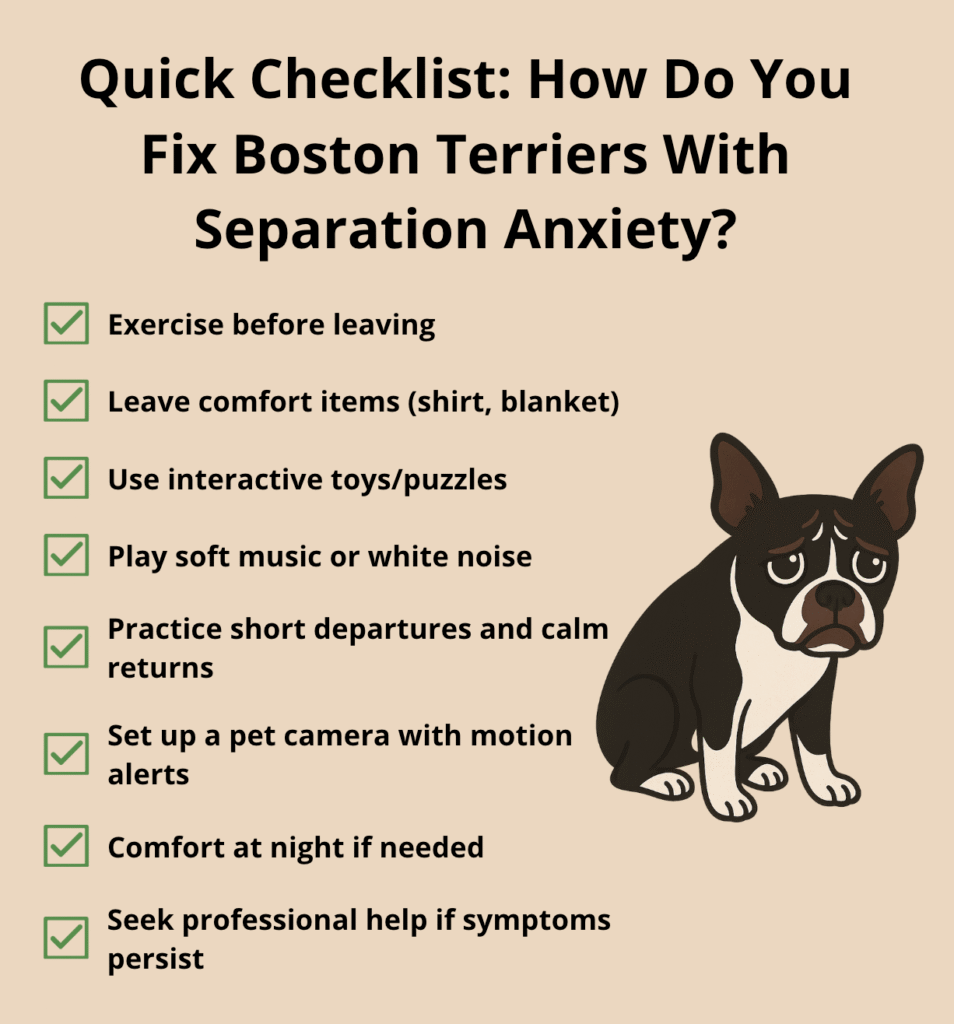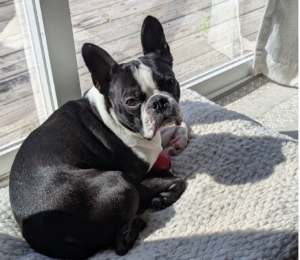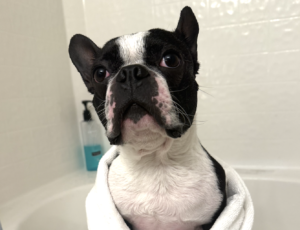Separation anxiety is not simply “missing you.” It is a clinically recognized emotional disorder in dogs. For Boston Terriers, who have been bred for companionship for generations, the risk is even greater.
“Dogs like Boston Terriers, who form strong attachments to their people, are far more vulnerable to anxiety when left alone. The absence of their primary attachment figure can cause genuine distress, triggering a cascade of behavioral and physiological changes.”
Author: Dr. Barbara L. Sherman, DVM, PhD, DACVB
In practical terms, this means that your Boston Terrier’s distress is real, not imaginary. When you leave, his world changes. The familiar rhythms—your voice, your footsteps, your presence—vanish. For some dogs, this vacuum is filled with uncertainty, even panic.
Why Does This Happen? The Science Behind the Struggle
The Boston Terrier’s affectionate temperament is the product of deliberate breeding. From their earliest days, they have been selected for their social skills and their intense need for closeness.
That emotional closeness, while wonderful for bonding, can be a double-edged sword.
“It is important to realize that the destruction and house soiling that often occurs with separation anxiety is not the dog’s attempt to punish or seek revenge on its owner for leaving it alone, but is actually part of a panic response.”
Authors: Debra Horwitz, DVM, DACVB & Gary Landsberg, DVM, DACVB, DECAWBM (Both are board-certified veterinary behaviorists).
A Boston Terrier who has always had company—whether from a human or another dog—may find solitude deeply unsettling. Major changes, such as moving homes, changes in the family, or even just your return to a busy work schedule, can trigger or worsen the problem.
Signs and Symptoms: What the Experts See
Veterinary behaviorists have carefully documented the spectrum of separation anxiety behaviors. In Boston Terriers, the most common signs include:
- Destructive actions: Chewing, scratching, or digging at doors and windows (often focused on escape routes).
- Vocalizations: Persistent barking, howling, or whining, especially shortly after you leave.
- House soiling: Urinating or defecating indoors, even when house-trained.
- Loss of appetite: Some dogs refuse food or treats until their owner returns.
- Physical stress: Excessive panting, drooling, trembling.
- Repetitive movements: Pacing, circling, or waiting by the door for long periods.
- Self-soothing or self-harm: Licking or chewing paws, sometimes until sores develop.
“If these behaviors are observed only when the dog is left alone and disappear when you return, separation anxiety is the likely culprit.”
Personal Experience: Dumpling and the Power of Routine
With my own Boston Terrier, Dumpling, separation anxiety revealed itself gradually. When I first began working outside the home again, I noticed he would follow me from room to room—never letting me out of sight.
The first few times I left for more than an hour, he barked and paced at the door, sometimes refusing food until I returned.

What changed everything was establishing a predictable, gentle routine.
Every morning before leaving, I’d take him for a long walk, then offer a favorite puzzle toy filled with treats. Most importantly, I made my departures boring—no dramatic goodbyes, just a calm “See you soon, buddy.”
Through a pet camera with motion alerts, I learned something powerful:
1. When Dumpling was calm—maybe sitting quietly by the door for a few minutes, then settling on the couch—I left him alone.
2. But when I saw him agitated, circling, or barking, I could use the camera’s two-way audio to offer a few soothing words. If he was resting, I said nothing—because peace, not constant attention, is what he needed to learn.
Modern cameras notify me if Dumpling moves around more than usual. The mobile app means I can check in only when needed, without hovering or accidentally waking him up.
If you want to monitor and support your Boston Terrier while you’re away, I highly recommend the PETLIBRO Pet Camera with Auto-Tracking & Multi-Pet Recognition.
Why is this camera a game-changer for Boston Terrier separation anxiety?
- Crystal-Clear Video & Audio: See and hear your Boston clearly, day or night.
- Auto-Tracking & Multi-Pet Recognition: The camera automatically follows your dog, sends smart notifications, and distinguishes between pets.
- Two-Way Talk: You can reassure your Boston with your voice only if you see real signs of stress (not just to say hello).
- Motion Alerts & Activity Summaries: Instantly know if your Boston is pacing, barking, or showing signs of anxiety—even at night.
- Easy Setup & App: Get alerts right on your phone, so you don’t have to check constantly.

PETLIBRO AI Dog Camera Pet Camera Indoor with Phone App
Leaving for Work or School (8-Hour Day)
Here’s how to minimize stress:
- Morning exercise: A tired dog is a calm dog. A brisk walk or play session sets a peaceful tone.
- Comfort objects: Leave behind a shirt that smells like you. This “security blanket” works wonders.
- Interactive toys or treat puzzles: Give your Boston a mission while you’re out.
- Background sound: Leave on calm music, audiobooks, or a dog TV channel.
- Pet cameras with motion alerts: Get instant phone notifications if your Boston moves or vocalizes. Modern cameras let you see, hear, and even talk to your pet.
But: Only speak through the camera if your dog is actually distressed (barking, destroying, etc.), never just to “check in.” If your Boston is resting or waiting by the door calmly, let them be.
Personal tip: Dumpling, my Boston, sometimes sits by the door for a couple minutes and then walks away. I’ve learned – don’t disturb him if he’s calm — it teaches him patience and trust.
Leaving for Vacation or Extended Absence
What if you’re gone for days? Preparation is key.
Care Options:
- Familiar friends or family: Leave your Boston with someone they know, ideally in your home.
- Professional pet sitters: Arrange trial visits before the trip.
- Doggy daycare or reputable boarding: Visit the facility ahead of time; bring your Boston’s own bed, toys, and feeding routine.
Transition Tips:
- Gradual goodbyes: Try “practice separations” before leaving for your trip.
- Leave a care routine: Written instructions make everyone’s life easier.
- Send favorite belongings: Blanket, toys, and worn T-shirt.
- Consider a pheromone collar or spray: Ask your vet.
- Video and voice calls: For some anxious Bostons, a short message from you can help — but don’t overdo it.
Advice for temporary caregivers:
Stick to the normal schedule. Stay calm. Shower your Boston with gentle attention — but don’t “over-comfort.”
Normal Behavior vs. Separation Anxiety in Boston Terriers
| Behavior | Normal Alone-Time | Separation Anxiety Warning |
|---|---|---|
| Sleeping | Calm, regular sleep | Whining, barking, insomnia, pacing |
| Eating | Eats normally | Won’t touch food until owner returns |
| Greeting owner | Excited, settles quickly | Wild, frantic, long-lasting excitement |
| Chewing | Gentle on toys | Destroys furniture, doors, personal items |
| Bathroom habits | Uses designated spot | Accidents indoors, even if trained |
How Do You Fix a Dog with Separation Anxiety – Step-by-Step Guide
- Establish a Predictable Routine
Regular walks, feeding, and playtimes create a sense of security. - Practice Short Departures
Start by leaving your Boston for just a few minutes, then gradually increase the time. Always return calmly. - Make Departures and Arrivals Low-Key
Avoid big emotional hellos or goodbyes. Calm signals = calm dog. - Provide Comfort Objects
Leave a shirt or blanket that smells like you. Many dogs find this incredibly soothing. - Interactive Toys and Puzzles
Food-dispensing toys keep your dog mentally occupied while you’re away. - Background Sound
Soft music or white noise can mask unsettling noises from outside. - Use a Pet Camera (with motion alerts and two-way audio)
Only interact through the camera if your Boston is distressed (barking, destructive, etc.), never just to say “hi.”
Tip from experience: Dumpling settles best when left alone unless he’s showing real anxiety. If he’s resting or calmly waiting, I don’t disturb him—even if it’s tempting. - Special Approach for Nighttime
If your Boston Terrier struggles at night, try a nightlight, a cozy bed in your room, or gentle background noise. Some Bostons need to be near their human at night to feel secure. - Consult a Professional if Needed
If your dog’s anxiety is severe, consult a board-certified veterinary behaviorist.
Sometimes, medication (fluoxetine or clomipramine) may be prescribed to help with the transition.

FAQ
-
Are Boston Terriers One Person Dogs?
Boston Terriers often form especially close bonds with one member of the family, sometimes described as “one person dogs.” However, with good socialization, they can be loving with everyone. Their loyalty to their primary caregiver is legendary.
-
Can Boston Terriers Be Left Alone?
Yes, but with limits. Most Boston Terriers can be left alone for a workday (6–8 hours) if properly trained and provided with toys, background sound, and comfort objects. Puppies, dogs with severe anxiety, or seniors may need special care and shorter absences.
-
Why Are Boston Terriers So Clingy?
Clinginess is part of their charm—and challenge. Boston Terriers bond deeply and thrive on close contact. This trait makes them affectionate, devoted companions, but also more susceptible to separation anxiety, especially if their needs for companionship are not met.







